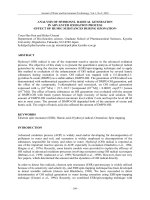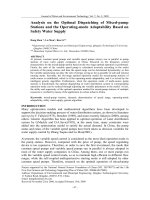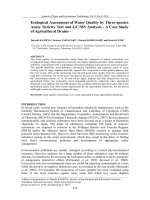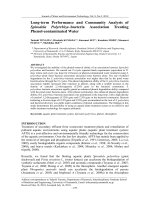Pvt analysis 1
Bạn đang xem bản rút gọn của tài liệu. Xem và tải ngay bản đầy đủ của tài liệu tại đây (2.92 MB, 55 trang )
4/9/2018
PVT Analysis
Nguyen Le Anh Tu
9th April 2018
1
4/9/2018
Why PVT?
2
We need to know
1. Composition of the production well stream and its temporal variation
2. Separator specifications including LPG
Design of the completions by identifying the spatial fluid distribution in
the vicinity of the wellbore
4. Gas injection/re-injection
• Identifying gas composition
• The interaction of injected gas and reservoir fluid
4/9/2018
Why PVT?
3.
3
5.
Ultimate recoveries of components, under different drives, mixing/no
mixing, single depletion, etc.
6.
Amounts and composition of liquids left in the reservoir not recovered
(especially in gas condensate reservoirs) and its properties: density,
Surface Tension, viscosity.
7.
Detect spatial variation of PVT properties.
8.
Identify and adjust data inconsistencies.
4/9/2018
Why PVT?
4
Why PVT?
Calibrate Equations of State (EOS)
4/9/2018
True Objective of gathering and analyzing PVT data
Reason:
• We cannot measure all characteristic of hydrocarbon fluids. EOS provides
one consistent source of PVT data
• Experiment problems (cost, reliability, accuracy and precision)
5
Reservoir Fluid Composition
𝑪𝒏 𝑯𝟐𝒏+𝒉 𝑺𝒂 𝑵𝒃 𝑶𝒄
4/9/2018
• Hydrocarbon components can be expressed by the general
formula:
dependent of
hydrocarbon classes
6
Reservoir Fluid Composition
• Alkanes or Paraffins (h=2) have completely saturated hydrocarbon chains
that are chemically very stable.
4/9/2018
The major classes of hydrocarbon are:
• Alkenes or Olefins (h=0) have unstable straight chains (unstable nature) and
rarely found in reservoir but an important part in downstream business.
• Naphthenes or Cycloparaffins (h=0) saturated ring or cyclic compounds
rarely found in crude oil.
• Aromatics or Benzene series (h=6) are unsaturated cyclic compound.
• Asphaltenes and Resins (increasingly negative h) are aromatics and
polycyclic hydrocarbon with fuse rings contain N,S,O and metals such as
Nickel and Vanadium.
7
Alkanes or Paraffins
Long chain paraffins (carbon no >15)
forming solids at surface but will remain in
solution at reservoir condition
4/9/2018
• What are Waxes?
8
4/9/2018
Naphthenes or Cycloparaffins
• At low carbon numbers (below 5) Cycloparaffins are less stable than normal
Paraffins, hence rarely found in the reservoir.
9
Aromatics
4/9/2018
• Aromatics contain one or more
Benzene rings
10
• Fused rings means two or
more rings which have two
carbon atoms in common.
4/9/2018
Asphaltenes and Resins
• The polar nature of
asphaltenes can affect the
properties of reservoir
fluids, particularly the rock
fluid behavior.
11
Non-hydrocarbon components
• Nitrogen (N2) which reduce the calorific value and hence sale price of gas.
4/9/2018
• Sulfur and its products such as H2S which is highly toxic and corrosive.
• Carbon dioxide (CO2) is a source of corrosion problem and occurs at points
where there is turbulent flow such as in producing tubing, piping and
separators.
• Metals such as Vanadium, Nickel, Copper, Zinc and iron.
12
Reservoir Fluid Composition
Gas Chromatography / distillation
4/9/2018
Test method to determine components within a reservoir fluid.
13
Reservoir Fluid Composition
• PNA test: measure the concentration of Paraffins, Naphthenes and
Aromatics
4/9/2018
The common test methods to determine hydrocarbon classes are:
• SARA test: measure the concentration of Saturates, Aromatics, Resins and
Asphaltenes
• Strieter test: measure the concentration of asphaltenes, Resins and Oils.
14
Classification of reservoir fluid
How many type of reservoir fluids are there?
4/9/2018
• Dry Gas
• Wet Gas
• Retrograde Condensate
• Black Oil
• Volatile Oil
Phase behavior of main types of
hydrocarbon reservoir (from IFP book)
15
4/9/2018
Classification of reservoir fluid
The API and GOR are not absolute indicators of reservoir fluid type, and are a
function of separator conditions.
16
Dry Gas
• Dry not only in reservoir but also on
surface.
4/9/2018
• Mainly composed of methane and
non-hydrocarbon such as N2 and
CO2.
• Normal material balance equation
(P/Z vs. gas cumulative production)
can be applied.
• Water may condense at surface
condition due to the gas cooling
• PVT test in the laboratory are limited
to the gas compressibility
measurements (Z factor) and
viscosity.
17
• The composition of the gas is equal to the gas composition in the reservoir,
and the specific gas gravity of the gas is also equal to the specific gravity of
the reservoir gas . Hence specific gravity of the surface gas can be used to
determine the properties od the gas in the reservoir.
4/9/2018
Dry Gas Properties
• Gas Formation Volume Factor (Bg): is defined as the volume of gas at
reservoir conditions required to produce one standard cubic foot of gas at
surface:
• Gas Expansion Factor: is the reciprocal of the formation volume factor and
is in the order of hundred.
18
Dry Gas Properties
1. If an experimental value of Z-factor at reservoir temperature and pressure
is available for the gas of interest , it should be used.
4/9/2018
The value of Z-factor or gas compressibility factor may be obtained by several
methods as:
2. If an experimental value is unavailable but the composition of the gas in
known, the pseudo reduced temperature and pressure can be computed
and then Z-factor.
3. If only the specific gravity of the gas is known, the pseudocritical
properties can be computed then Standing –Katz Z-factor can be used to
estimate Z-factor.
19
4/9/2018
Dry Gas Properties
20
The coefficient of isothermal Compressibility of Gas (Cg): or gas
compressibility is defined as the fractional change of volume as pressure is
changed at constant temperature and the unit is (1/psi). It must not be
confused with compressibility factor of Z-factor. Although both are related to
the effect of pressure on the volume of a gas.
4/9/2018
Dry Gas Properties
Compressibility of real gases are as:
21
Gas Viscosity: viscosity of gases generally ranges from 0.01 to 0.03 cp at
standard reservoir conditions, reaching up to 0.1 cp for near critical
condensate. Experimental determination of gas viscosity is difficult, thus the
prediction of gas viscosity is important.
4/9/2018
Dry Gas Properties
• Most PVT laboratories use the Lee et al or Carr et al correlations when
reporting gas viscosity.
• The accuracy of Lee- Gonzalez correlation is generally at 2-4% but might rich
as high as 20% for rich gas condensate while Carr et all is around 3%.
22
Wet Gas
• Dry only in reservoir but producing
condensate at the surface.
4/9/2018
• Mainly composed of methane and
other light components.
• Wet gas will not drop-out condensate
in the reservoir during depletion.
• Material balance equation for dry gas
can still be used as no condensate is
formed in the reservoir.
23
• Gas compressibility (Z factor) an
viscosity are the PVT test required at
the reservoir condition in addition to
separator test at surface condition to
determine the amount of condensate
4/9/2018
Wet Gas (cont.)
• Producing GOR’s are typically below
20 stb/mmscf and remain constant
during production.
• Condensate color is usually waterwhite with high API and remain
unchanged during depletion.
24
For wet gas , the key is to identify the reservoir gas composition. Once the
composition of the reservoir gas has been calculated, its physical properties
can be calculated as for a dry gas.
4/9/2018
Wet Gas Properties
25









